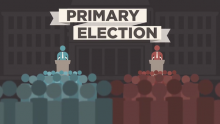Canadians sometimes wonder why Americans take two years to pick a president. This question comes to mind especially in the midst of the drawn-out series of United States presidential primaries.
And what are primaries? This week, the Munk School of Global Affairs at the University of Toronto brought political analyst Henry Olsen to Toronto from Washington D.C. to offer insights.
“In Canada, you select your party leaders by a method that we consider highly closed,” Olsen said during his talk, “A Primer on Primaries.” The process in the U.S. is more open and much more complicated as a result, he said.
In state after state, members of the Republican Party are voting for a presidential candidate from a slate of 14 people, while Democrats are going through a parallel process for their three candidates.
The primaries, however, can be as baffling as they are long:
1. Party members vote so that their delegates attend a national convention to vote for their candidate, Olsen explained. So, when Bernie Sanders won 60 per cent of the vote in New Hampshire on Feb. 9, he gained 15 delegates who would vote for him at the Democratic national convention in July.
2. States get delegates based on population. For example, while Republicans in New Hampshire will send 23 delegates to their national convention, California will send about 170. This means that Donald Trump’s strong showing in New Hampshire’s primary (10 of 23 delegates) doesn’t mean much because he has to do well in bigger states, Olsen said.
Primaries are held in one state after another, from February to June, but when one candidate gets more than half of the national delegates, the decision is basically made. Olsen predicted that Clinton will gain half the delegates (2,242 of them) by March 15, in spite of Sanders’ strong showing in the first few primaries.
“Older women, 50 and up, are Hilary Clinton’s bedrock support in the Democratic primary,” said Olsen, who’s a senior fellow at the U.S.-based Ethics and Public Policy Center. She also has strong support from African-American communities, who are much more populous and back her by margins of three-to-one over Bernie Sanders, he explained.
The Republican race will be more chaotic, said Olsen, who’s writing a book called Rise of the New Deal Republicans: How the FDR-Reagan Consensus Can Save Today’s GOP. He outlined four voting factions that are ideologically at odds with one another. The first is conservative evangelical Christians, he said. Republican Ted Cruz ignites these voters, but they’re a minority.
Three other factions (“moderates,” “somewhat conservative” and “fiscal, secular conservatives”) always team up to counter evangelicals like Cruz and wildcards like Trump.
But Trump is attracting a new type of Republican voter for the primaries, people who don’t usually vote, Olsen said. These are under-educated voters struggling to keep jobs or to find work and who feel threatened by immigration and free-trade deals, he explained.
He predicted that the three main Republican factions will eventually line up behind Marco Rubio, a moderate, just as Democratic factions will back Clinton.
U of T student Milan Bernard didn’t agree. He studies political theory and said that Olsen could be underestimating how people jump on bandwagons. In his heart, Bernard felt that Sanders would win the presidential nomination.
“But getting an analytical view is interesting,” he said of Olsen. “It’s a right-wing view from someone who can think.”
Jason Vandenbeukel, a U of T Canadian politics student, agreed. “The most interesting thing I took out of it was how he summed up a battle between Rubio and Clinton,” Vandenbeukel said. “I can see a Republican establishment salivating over a Rubio-Clinton battle.”
But there are still months of primaries before that day.
ALEX GILLIS
February 12, 2016.
